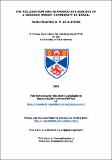Files in this item
The pollination and reproductive biology of a cerrado woody community in Brazil
Item metadata
| dc.contributor.advisor | Gibbs, P. E. | |
| dc.contributor.author | Oliveira, Paulo Eugenio A. M. de | |
| dc.coverage.spatial | xii, 138 p. | en_US |
| dc.date.accessioned | 2014-04-29T11:05:53Z | |
| dc.date.available | 2014-04-29T11:05:53Z | |
| dc.date.issued | 1992 | |
| dc.identifier | uk.bl.ethos.492707 | |
| dc.identifier.uri | https://hdl.handle.net/10023/4657 | |
| dc.description.abstract | The pollination biology and reproduction of a woody plant community of cerrado, the neotropical savanna vegetation in Brazil, was studied. A delimited area of relatively dense cerrado which included 59 woody species was studied from July 1988 to September 1989 in the Ecological Reserve area of Brasilia Botanic Garden. Aspects of the phenology, floral biology, breeding systems and fruit-set patterns were studied for the whole community or for a subsample of the species in the area. Some species, group of species or aspects of the reproductive biology of these plants were further analyzed in separate case history studies. The species in the community showed varied phenological behaviour with vegetative growth and reproduction distributed throughout the year. It seems that the phenology of adult individuals is, to a certain extent, independent of the markedly seasonal wet and dry climate of the area. Only the seedling establishment seems to be confined to a specific period at the beginning of the rains. Wind and animal dispersal mechanisms are partially constrained showing two different peaks but flowering phenology seems to be much more flexible and even for congeneric species flowering periods may differ markedly. The phenological strategy of each species seems to be a more or less independent assemblage of the possible options in each phenophase. The plants could be grouped in seven pollination guilds based on their main pollinators. These guilds were basically similar to the ones described for other tropical communities. Unspecialized flowers pollinated by small insects, including flies, wasps and small bees formed the most Common group. The more conspicuous and specialized flowers pollinated by medium to large, long-tongued bees formed the second most important group. Other characteristically tropical pollination systems such as bat and beetle pollination were also present. Hummingbird pollination was rare and wind and butterfly pollinated flowers were absent. The fauna of visitors, their foraging habits and possibly their seasonal segregation is similar to that described for Costa Rican seasonal forests, particularly in the case of the large bee fauna. No pollination system seems to be seasonally limited although a peak of large bee pollinated flowers, for example, could be identified at the onset of the rains. Breeding systems could be established for a sample of 22 species with different pollination systems, the majority (86%) of which presented self-incompatibility mechanisms. This sample and the frequency of dioecious species (15% of the total) permitted an estimate of 84% as the frequency of obligatory outcrossing species in the area. Such frequency is similar to those obtained for other lowland tropical forest communities and much higher than the estimates for altitudinal cloud forests in the tropics. Apomixis was present in two species in the community and is possibly present in another two, which indicate that, although rare, this may be an important phenomenon amongst the cerrado woody species. The site of the incompatibility reaction was studied for most of the self-incompatible species and a majority presented "lateacting self-incompatibility", with self-pollen tubes reaching the ovary or even penetrating the ovule. More "classical" self-pollen tube arrest in the style was also observed for some groups. Fruit-set was usually low but the data should be regarded with caution since they varied both spatially and temporally. Nevertheless, some differences between pollination system groups and relationships with breeding system are suggested by the results. The case history studies involved a self-incompatible shrub species, Yellozia squamata (Velloziaceae), which presented a distinct flowering phenology; a bat-pollinated tree, Hymenaea stigonocarpa (Leg. Caesalpinioideae), which presented "late acting self-incompatibility"; another legume tree, Sclerolobium paniculatum, which present two varieties segregated ecologically but which were not clearly isolated reproductively; contrasting breeding systems, self-incompatibility and apomixis, in two cerrado Eriotheca spp. (Bombacaceae); six species of Vochysia (Vochysiaceae) which occur in different vegetation physiognomies in the Ecological Reserve of the Brasilia Botanic Garden but have very similar floral biology and outbreeding system; a study on some small "settling" moth pollinated species in the study area which have similar outbreeding systems as their large hawkmoth pollinated counterpart; and a general study on the occurrence of dioecy which is less important in cerrado areas than in the contiguous forest habitats. The breeding features emerging from this study support the idea of the cerrado vegetation as stable communities where biomass output is possibly limited by availability of nutrients and restrict establishment conditions, but not restricted by seasonality or disturbance in terms of opportunity and predictability for the reproductive process of the woody plants. If outbreeding systems are indicative of environmental stability, then cerrado conditions seems to be comparable to those in the lowland tropical forest. | en_US |
| dc.language.iso | en | en_US |
| dc.publisher | University of St Andrews | |
| dc.rights | Creative Commons Attribution-NonCommercial-NoDerivatives 4.0 International | |
| dc.rights.uri | http://creativecommons.org/licenses/by-nc-nd/4.0/ | |
| dc.title | The pollination and reproductive biology of a cerrado woody community in Brazil | en_US |
| dc.type | Thesis | en_US |
| dc.contributor.sponsor | Brazilian Research Council CNPq | en_US |
| dc.type.qualificationlevel | Doctoral | en_US |
| dc.type.qualificationname | PhD Doctor of Philosophy | en_US |
| dc.publisher.institution | The University of St Andrews | en_US |
This item appears in the following Collection(s)
Except where otherwise noted within the work, this item's licence for re-use is described as Creative Commons Attribution-NonCommercial-NoDerivatives 4.0 International
Items in the St Andrews Research Repository are protected by copyright, with all rights reserved, unless otherwise indicated.


